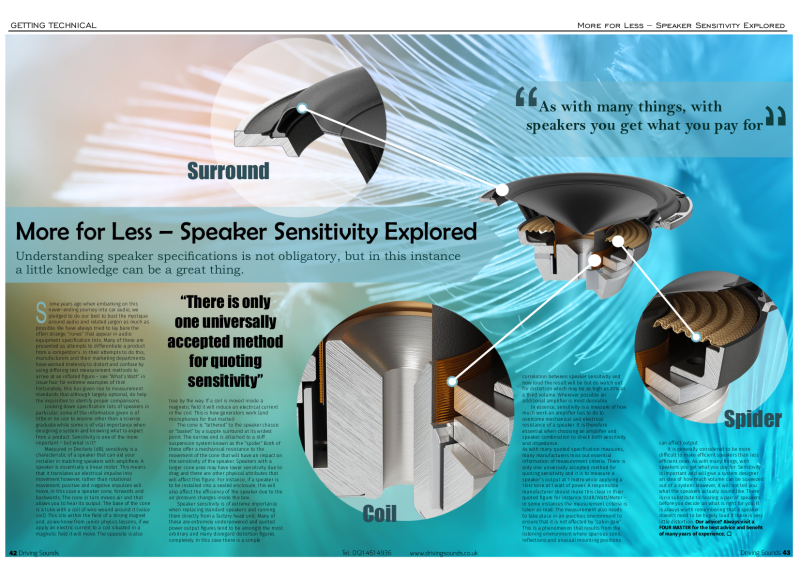
More for Less – Speaker Sensitivity Explored
Some years ago when embarking on this never-ending journey into car audio, we pledged to do our best to bust the mystique around audio and related jargon as much as possible. We have always tried to lay bare the often strange “runes” that appear in audio equipment specification lists. Many of these are presented as attempts to differentiate a product from a competitor’s. In their attempts to do this, manufacturers and their marketing departments have worked tirelessly to distort and confuse by using differing test measurement methods to arrive at an inflated figure – see “What’s Watt” in issue four for extreme examples of this! Fortunately, this has given rise to measurement standards that although largely optional, do help the inquisitive to identify proper comparisons.
Looking down specification lists of speakers in particular, some of the information given is of little or no use to anyone other than a science graduate while some is of vital importance when designing a system and knowing what to expect from a product. Sensitivity is one of the more important – but what is it?
Measured in Decibels (dB), sensitivity is a characteristic of a speaker that can aid your installer in matching speakers with amplifiers. A speaker is essentially a linear motor. This means that it translates an electrical impulse into movement however, rather than rotational movement, positive and negative impulses will move, in this case a speaker cone, forwards and backwards. The cone in turn moves air and that allows you to hear its output. The base of the cone is a tube with a coil of wire wound around it (voice coil). This sits within the field of a strong magnet and, as we know from junior physics lessons, if we apply an electric current to a coil situated in a magnetic field it will move. The opposite is also true by the way. If a coil is moved inside a magnetic field it will induce an electrical current in the coil. This is how generators work (and microphones for that matter)
The cone is “tethered” to the speaker chassis or “basket” by a supple surround at its widest point. The narrow end is attached to a stiff suspension system known as the “spider” Both of these offer a mechanical resistance to the movement of the cone that will have an impact on the sensitivity of the speaker. Speakers with a larger cone area may have lower sensitivity due to drag and there are other physical attributes that will affect this figure. For instance, if a speaker is to be installed into a sealed enclosure, this will also affect the efficiency of the speaker due to the air pressure changes inside the box.
Speaker sensitivity is of extreme importance when replacing standard speakers and running them directly from a factory head unit. Many of these are extremely underpowered and quoted power output figures tend to be amongst the most arbitrary and many disregard distortion figures completely. In this case there is a simple correlation between speaker sensitivity and how loud the result will be but do watch out for distortion which may be as high as 20% at a third volume. Wherever possible an additional amplifier is most desirable.
In essence, sensitivity is a measure of how much work an amplifier has to do to overcome mechanical and electrical resistance of a speaker. It is therefore essential when choosing an amplifier and speaker combination to check both sensitivity and impedance.
As with many quoted specification measures, many manufacturers miss out essential information of measurement criteria. There is only one universally accepted method for quoting sensitivity and it is to measure a speaker’s output at 1 meter while applying a 1kHz tone at 1 watt of power. A responsible manufacturer should make this clear in their quoted figure for instance: 92dB/Watt/Meter – in some instances the measurement criteria is taken as read. The measurement also needs to take place in an anechoic environment to ensure that it is not affected by “cabin gain”. This is a phenomenon that results from the listening environment where spurious sonic reflections and unusual mounting positions can affect output.
It is generally considered to be more difficult to make efficient speakers than less efficient ones. As with many things, with speakers you get what you pay for. Sensitivity is important and will give a system designer an idea of how much volume can be squeezed out of a system. However, it will not tell you what the speakers actually sound like. There is no substitute to hearing a pair of speakers before you decide on what is right for you. It is always worth remembering that a speaker doesn't need to be hugely loud if there is very little distortion.
Our advice? Always visit a FOUR MASTER for the best advice and benefit of many years of experience.
Find out what our partner, The FOUR MASTER Network, can do to bring Hi-Fi quality to your car. Simply put some brief details into the form below.
Not ready for that yet? You can use the same form to book a demonstration at your home, place of work or with your local FOUR MASTER
